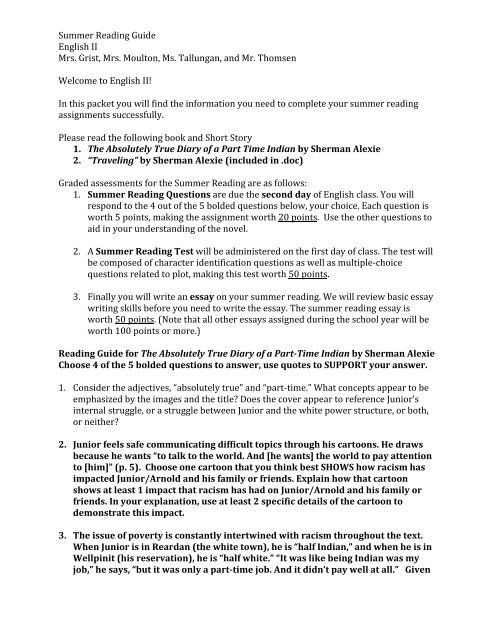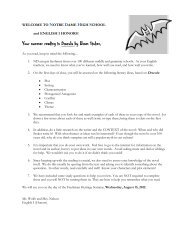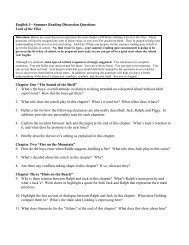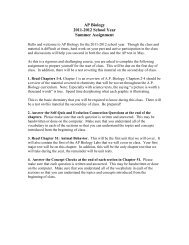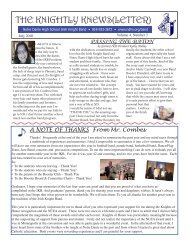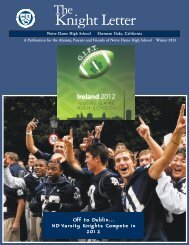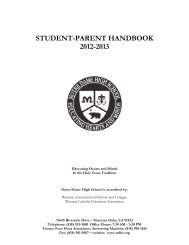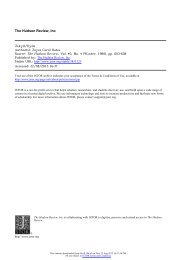Summer Reading Guide English II Mrs. Grist, Mrs. Moulton, Ms ...
Summer Reading Guide English II Mrs. Grist, Mrs. Moulton, Ms ...
Summer Reading Guide English II Mrs. Grist, Mrs. Moulton, Ms ...
You also want an ePaper? Increase the reach of your titles
YUMPU automatically turns print PDFs into web optimized ePapers that Google loves.
<strong>Summer</strong> <strong>Reading</strong> <strong>Guide</strong> <strong>English</strong> <strong>II</strong> <strong>Mrs</strong>. <strong>Grist</strong>, <strong>Mrs</strong>. <strong>Moulton</strong>, <strong>Ms</strong>. Tallungan, and Mr. Thomsen Welcome to <strong>English</strong> <strong>II</strong>! In this packet you will find the information you need to complete your summer reading assignments successfully. Please read the following book and Short Story 1. The Absolutely True Diary of a Part Time Indian by Sherman Alexie 2. “Traveling” by Sherman Alexie (included in .doc) Graded assessments for the <strong>Summer</strong> <strong>Reading</strong> are as follows: 1. <strong>Summer</strong> <strong>Reading</strong> Questions are due the second day of <strong>English</strong> class. You will respond to the 4 out of the 5 bolded questions below, your choice. Each question is worth 5 points, making the assignment worth 20 points. Use the other questions to aid in your understanding of the novel. 2. A <strong>Summer</strong> <strong>Reading</strong> Test will be administered on the first day of class. The test will be composed of character identification questions as well as multiple-‐choice questions related to plot, making this test worth 50 points. 3. Finally you will write an essay on your summer reading. We will review basic essay writing skills before you need to write the essay. The summer reading essay is worth 50 points. (Note that all other essays assigned during the school year will be worth 100 points or more.) <strong>Reading</strong> <strong>Guide</strong> for The Absolutely True Diary of a Part-‐Time Indian by Sherman Alexie Choose 4 of the 5 bolded questions to answer, use quotes to SUPPORT your answer. 1. Consider the adjectives, “absolutely true” and “part-‐time.” What concepts appear to be emphasized by the images and the title? Does the cover appear to reference Junior’s internal struggle, or a struggle between Junior and the white power structure, or both, or neither? 2. Junior feels safe communicating difficult topics through his cartoons. He draws because he wants “to talk to the world. And [he wants] the world to pay attention to [him]” (p. 5). Choose one cartoon that you think best SHOWS how racism has impacted Junior/Arnold and his family or friends. Explain how that cartoon shows at least 1 impact that racism has had on Junior/Arnold and his family or friends. In your explanation, use at least 2 specific details of the cartoon to demonstrate this impact. 3. The issue of poverty is constantly intertwined with racism throughout the text. When Junior is in Reardan (the white town), he is “half Indian,” and when he is in Wellpinit (his reservation), he is “half white.” “It was like being Indian was my job,” he says, “but it was only a part-‐time job. And it didn’t pay well at all.” Given
this perspective, why does Junior pretend he has more money than he does at Reardan, even though he knows “lies have short shelf lives”? 4. Junior describes his reservation as “located approximately one million miles north of Important and two billion miles west of Happy.” Yet when he and Rowdy look down from almost the top of an immense pine, he says, “We could see our entire world. And our entire world, at that moment, was green and golden and perfect.” What forces drive the dichotomy of Junior’s perceptions of his world and allow him to see the land in apparently disparate ways? 5. Cultural outsiders who write young adult fiction tend to romanticize the impoverishment of Indians. Junior is having none of this: “It sucks to be poor, and it sucks to feel that you some-‐ how deserve to be poor. You start believing that you’re poor because you’re stupid and ugly. And then you start believing that you’re stupid and ugly because you’re Indian. And because you’re Indian you start believing that you’re destined to be poor. It’s an ugly circle and there’s nothing you can do about it. Poverty doesn’t give you strength or teach you lessons about perseverance. No, poverty only teaches you how to be poor.” How does Junior’s description of being Indian relate to the stereotypes addressed in the novel? How might this relate to a specific aspect of his life? Consider how he views his parents potential or Rowdy’s. 6. Junior’s parents, Rowdy’s father, and others in their community are addicted to alcohol, and Junior’s white “friend with potential,” Penelope, has bulimia. “There are all kinds of addicts, I guess,” he says. “We all have pain. And we all look for ways to make the pain go away.” How does Junior’s understanding of addiction transcend ethnicity and class? 7. At Junior’s grandmother’s funeral, Junior’s mother publicly gives a white billionaire his comeuppance to the delight of the whole community. “And then my mother started laughing,” Junior says. “And that set us all off. It was the most glorious noise I’d ever heard. And I realized that, sure, Indians were drunk and sad and displaced and crazy and mean, but dang, we knew how to laugh. When it comes to death, we know that laughter and tears are pretty much the same thing. And so, laughing and crying, we said goodbye to my grandmother. And when we said goodbye to one grandmother, we said goodbye to all of them. Each funeral was a funeral for all of us. We lived and died together.” How does this reflect a cultural insider’s perspective and how does it disrupt stereotypes about stoic Indians? 8. “I’m fourteen years old and I’ve been to forty-‐two funerals,” Junior says. “That’s really the biggest difference between Indians and white people.” In the community of Wellpinit, everyone is related, everyone is valued, every-‐ one lives a hardscrabble life, everyone is at risk for early death, and the loss of one person is a loss to the community. Compare Wellpinit to Reardan, whose residents have greater access to social services, health care, and wealth, and people are socially
distanced from each other. Using Junior’s statement above, what seems to be the real difference between the two towns, please use an example from the book to clarify your point. 9. In many ways, Junior is engulfed by the emotional realities of his life and his community. Yet his spare, matter-‐of-‐fact language and his keen sense of irony help him to confront and negotiate the hurt, the rage, and the senselessness of Wellpinit’s everyday realities. How does Junior use language to lead readers, whose lives may be very different from his own, to the kind of understanding that they will not get from young adult fiction whose writers do not have this kind of lived experience? 10. Cultural markers can be defined as the behaviors, speech patterns, ways of seeing the world, ethics, and principles that identify a per-‐ son as belonging to a particular culture. When Rowdy and Junior play one-‐on-‐one at the end of the book—and they don’t keep score—how is their friendship solidified by their deep knowing of who they are and what they come from?


